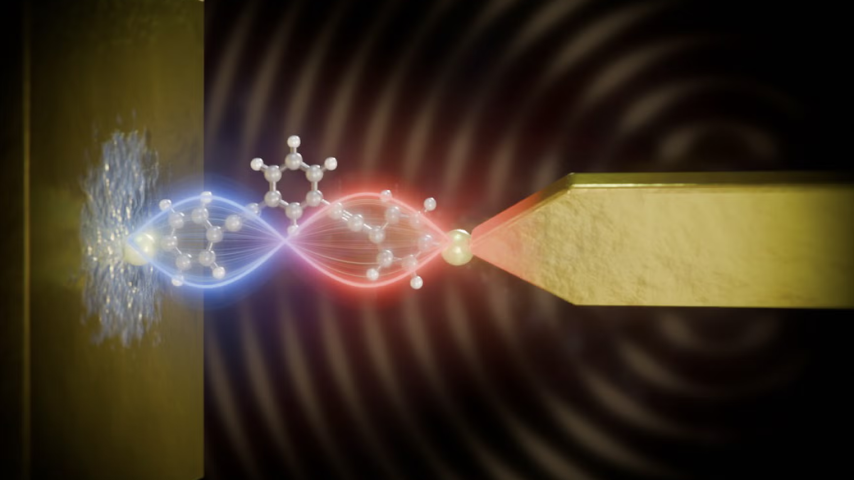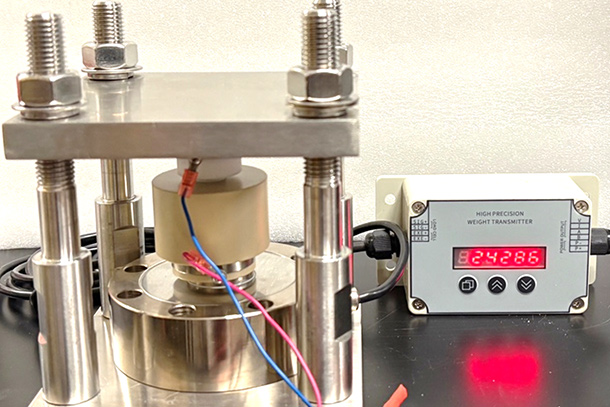A Mute Button to Control Heat
A Mute Button to Control Heat


An artistic depiction of thermal phonon interference in a molecule—creating what researchers call a “molecular song.”
Tiny thermal vibrations, also called phonons, can amplify or cancel each other out depending on how they're strung together, according to new research out of the University of Colorado, Boulder’s Paul M. Rady Department of Mechanical Engineering. This discovery could soon change the way heat dissipation is addressed in devices and materials.
Assistant professor Longji Cui envisions a future where users will be able to control heat, much like how humans can control sound waves.
"Can you just mute it like music? If you can control heat better, you get better energy efficiency since heat is always considered waste," Cui said.
You Might Also Like: Where Vibration Becomes Vibe
As detailed in, “Phonon interference in single-molecule junctions,” recently published in Nature Materials, the team investigated how they could amplify or cancel heat, much like how a mute button controls sound waves.
"You can imagine switching on and off the heat transfer by using specially designed structures," Cui said.
Any fundamental study to better understand and guide heat transfer on a small scale could have a big impact. Heat transfer issues have become far more prevalent with increasing use of AI, since it needs more energy, which will eventually become heat, Cui explained.
The ability to manipulate heat involves understanding phonons, which are quasi-particles formed by atomic vibrations due to temperature.
"Thermal vibration is another way called phonon,” Cui said. "Phonons on a high level are even more common than electrons. Phonons are truly everywhere."
The future of manipulating heat hinges on controlling these phonons, which are carriers for thermal transport. It’s much like electrons for electrical transport.
"This is a fundamental study. It's the first step to understanding how to move phonons the way we want," Cui said.
The researchers specifically studied phonon interference, which can amplify or change properties, making it easier to manipulate. Cui gave the analogy of two waves crashing and creating a disturbance.
"It's like using interference—kind of turning it on and off with much higher amplitude or contrast between two temperature sources," he said.
The study of heat transfer is called molecular phononics. Historically, it has been difficult to examine as no such system to study phonons existed and phonon interference is something that’s never been measured or observed at room temperature on a molecular scale.
"It is a phononic equivalent of molecular electronics. It is indeed a beginning and could be the first work we are doing now and could have made many more people follow and study every aspect of this," he added.
Cui's student Sai Yelishala, a researcher at UC Boulder, led the experiment. The study was a follow-up to a phonon study in a molecule from 2019. That paper pointed out some potential research challenges that included noise resolution, Yelishala said.
"I tried to improve the resolution to independently resolve each molecule. That gives us a platform to study what phonons do on different pathways,” Yelishala explained.
The researchers used a scanning tunneling microscope (STM) technique to trap a molecule to study phonons. Then, they fabricated a probe smaller than a grain of sand with niobium nitride, which has superconducting capabilities, and used it as a sensor to detect phonons.
The STM technique was used to trap single molecules. The nanofabricated sensor detected temperature changes.
"That lets us read the temperature change caused by the phonon moving in and out of this fabricated structure," Yelishala said.
Discover the Benefits of ASME Membership
There were countless control experiments regarding the noise and fluctuations, and many attempts to figure out the highest resolution technique.
"[Yelishala] took thousands of hours to make it happen. It's very challenging experimentally," Cui said.
The study is important as new-age materials and electronics have a long list of concerns when it comes to heat dissipation. It could take decades, but there could be devices that are able to make better use of the heat generated.
"Every electronic device could have a phonon analogy—a diode, a transistor, a TV, a computer," Cui said.
Agam Shah is a business and technology writer in Phoenix.
Assistant professor Longji Cui envisions a future where users will be able to control heat, much like how humans can control sound waves.
"Can you just mute it like music? If you can control heat better, you get better energy efficiency since heat is always considered waste," Cui said.
You Might Also Like: Where Vibration Becomes Vibe
As detailed in, “Phonon interference in single-molecule junctions,” recently published in Nature Materials, the team investigated how they could amplify or cancel heat, much like how a mute button controls sound waves.
"You can imagine switching on and off the heat transfer by using specially designed structures," Cui said.
Any fundamental study to better understand and guide heat transfer on a small scale could have a big impact. Heat transfer issues have become far more prevalent with increasing use of AI, since it needs more energy, which will eventually become heat, Cui explained.
The ability to manipulate heat involves understanding phonons, which are quasi-particles formed by atomic vibrations due to temperature.
"Thermal vibration is another way called phonon,” Cui said. "Phonons on a high level are even more common than electrons. Phonons are truly everywhere."
The future of manipulating heat hinges on controlling these phonons, which are carriers for thermal transport. It’s much like electrons for electrical transport.
"This is a fundamental study. It's the first step to understanding how to move phonons the way we want," Cui said.
The researchers specifically studied phonon interference, which can amplify or change properties, making it easier to manipulate. Cui gave the analogy of two waves crashing and creating a disturbance.
"It's like using interference—kind of turning it on and off with much higher amplitude or contrast between two temperature sources," he said.
The study of heat transfer is called molecular phononics. Historically, it has been difficult to examine as no such system to study phonons existed and phonon interference is something that’s never been measured or observed at room temperature on a molecular scale.
"It is a phononic equivalent of molecular electronics. It is indeed a beginning and could be the first work we are doing now and could have made many more people follow and study every aspect of this," he added.
Cui's student Sai Yelishala, a researcher at UC Boulder, led the experiment. The study was a follow-up to a phonon study in a molecule from 2019. That paper pointed out some potential research challenges that included noise resolution, Yelishala said.
"I tried to improve the resolution to independently resolve each molecule. That gives us a platform to study what phonons do on different pathways,” Yelishala explained.
The researchers used a scanning tunneling microscope (STM) technique to trap a molecule to study phonons. Then, they fabricated a probe smaller than a grain of sand with niobium nitride, which has superconducting capabilities, and used it as a sensor to detect phonons.
The STM technique was used to trap single molecules. The nanofabricated sensor detected temperature changes.
"That lets us read the temperature change caused by the phonon moving in and out of this fabricated structure," Yelishala said.
Discover the Benefits of ASME Membership
There were countless control experiments regarding the noise and fluctuations, and many attempts to figure out the highest resolution technique.
"[Yelishala] took thousands of hours to make it happen. It's very challenging experimentally," Cui said.
The study is important as new-age materials and electronics have a long list of concerns when it comes to heat dissipation. It could take decades, but there could be devices that are able to make better use of the heat generated.
"Every electronic device could have a phonon analogy—a diode, a transistor, a TV, a computer," Cui said.
Agam Shah is a business and technology writer in Phoenix.


.png?width=450&height=252&ext=.png)
.png?width=450&height=252&ext=.png)



